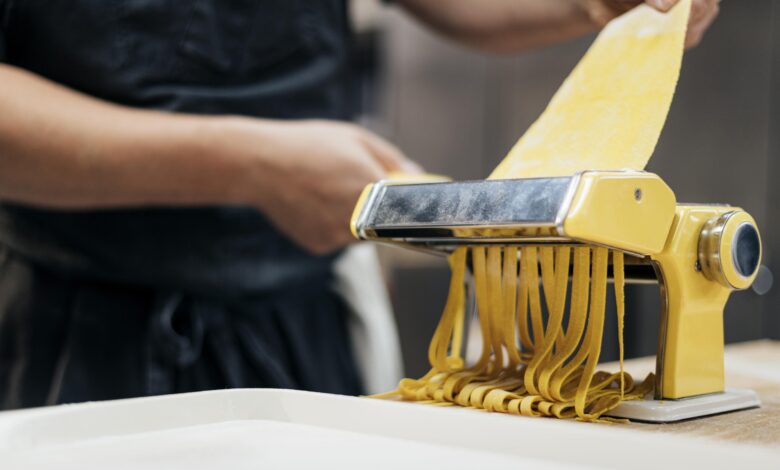Tortellinatrice: Complete Guide to Pasta Making Machines

The tortellinatrice is a specialized pasta-making machine designed to produce authentic tortellini, ravioli, and other filled pasta varieties with precision and consistency. For centuries, handmade pasta has been a symbol of Italian culinary tradition, but with growing demand and the need for efficiency in both restaurants and pasta factories, machines like the tortellinatrice have become essential. This guide will explore everything you need to know about the tortellinatrice, including its benefits, how it works, types available, and why it is transforming the pasta industry.
What is a Tortellinatrice?
A tortellinatrice is a pasta machine that automates the process of stuffing, shaping, and sealing tortellini or other filled pasta varieties. Traditional tortellini making is a time-consuming art that requires skill and patience, but modern pasta-making machines allow producers to create high-quality pasta at scale. Depending on the model, a tortellinatrice can produce pasta in different shapes, sizes, and fillings, making it a versatile tool for professional kitchens and industrial pasta production.
How a Tortellinatrice Works
The working mechanism of a tortellinatrice involves combining sheets of fresh pasta with a pre-prepared filling, then cutting and sealing them into uniform tortellini shapes. The machine ensures precise filling distribution, consistent sizing, and proper sealing, which prevents the pasta from opening during cooking. Advanced models come with adjustable settings that allow chefs to control dough thickness, filling quantity, and output speed, ensuring both efficiency and authenticity in the pasta-making process.
Benefits of Using a Tortellinatrice
Investing in a tortellinatrice offers numerous advantages for both small artisanal shops and large pasta factories.
-
Efficiency and Productivity – Speeds up the pasta-making process significantly compared to manual methods.
-
Consistency in Quality – Ensures uniform shape, weight, and filling in every tortellini produced.
-
Cost-Effectiveness – Reduces labor costs by minimizing the need for manual pasta preparation.
-
Versatility – Can produce not only tortellini but also ravioli, cappelletti, and other filled pasta.
-
Scalability – Allows small businesses to expand production without compromising on traditional quality.
These benefits make the tortellinatrice a must-have machine for modern pasta businesses.
Types of Tortellinatrice Machines
There are different types of tortellinatrice pasta machines, each designed to meet specific needs:
-
Manual Tortellinatrice – Best suited for small kitchens or artisanal pasta makers who prefer more control.
-
Semi-Automatic Tortellinatrice – Ideal for medium-sized businesses that need to increase output while maintaining quality.
-
Fully Automatic Tortellinatrice – Designed for large-scale pasta production, capable of producing thousands of tortellini per hour with minimal human intervention.
Choosing the right machine depends on the scale of production, budget, and desired customization in pasta shapes and fillings.
Tortellinatrice for Restaurants and Small Businesses
For restaurants and local pasta shops, a tortellinatrice machine can be a game-changer. It allows chefs to serve fresh, authentic tortellini daily without the limitations of manual preparation. Customers appreciate the consistency and freshness, while owners benefit from faster turnaround times and increased production capacity. Even smaller, compact tortellinatrice models are highly effective for kitchens that want to balance tradition with modern efficiency.
Industrial Tortellinatrice for Large-Scale Production
In industrial pasta manufacturing, a tortellinatrice is indispensable. These large machines are built to handle continuous high-volume production while maintaining the integrity of pasta shapes and fillings. Industrial models can be integrated into full pasta production lines, including mixers, extruders, and drying machines, creating a seamless operation from dough preparation to final packaging. This makes them the backbone of many pasta brands around the world.
Choosing the Best Tortellinatrice for Your Needs
When selecting a tortellinatrice, it is important to consider:
-
Production Capacity – The amount of pasta you plan to produce daily.
-
Machine Size and Space – The available kitchen or factory space.
-
Maintenance and Cleaning – Ease of disassembly and sanitation for food safety.
-
Customization Options – Ability to adjust size, shape, and filling.
-
Budget – Price varies depending on whether the machine is manual, semi-automatic, or fully automated.
Investing in the right machine ensures long-term efficiency, cost savings, and customer satisfaction.
Maintenance and Care of a Tortellinatrice
Proper maintenance is key to ensuring your tortellinatrice pasta machine runs smoothly for years. Regular cleaning after each production cycle prevents dough build-up and bacterial growth. Lubrication of moving parts and timely replacement of worn-out components also help extend the machine’s life. Many modern models are designed with easy-to-remove components, making cleaning faster and more efficient.
Conclusion
The tortellinatrice represents the perfect balance between Italian tradition and modern innovation. It preserves the authenticity of handmade tortellini while making pasta production faster, more efficient, and more accessible. Whether you run a small restaurant or manage an industrial pasta factory, investing in the right tortellinatrice can significantly enhance your production capacity, product quality, and overall customer satisfaction. With proper use and maintenance, this pasta-making machine becomes a long-term asset for any food business passionate about delivering the true taste of Italy.
Frequently Asked Questions (FAQ)
1. What is the main function of a tortellinatrice?
A tortellinatrice automates the process of filling, shaping, and sealing tortellini and other filled pasta varieties.
2. Can a tortellinatrice make other types of pasta?
Yes, many models can produce ravioli, cappelletti, and other stuffed pasta shapes in addition to tortellini.
3. Is a tortellinatrice suitable for small restaurants?
Absolutely. Compact models are available that suit small kitchens while still improving productivity.
4. How much does a tortellinatrice cost?
Prices vary depending on size and automation level, ranging from affordable manual machines to high-end industrial models.
5. How do I clean and maintain a tortellinatrice?
Most machines are designed with removable parts for easy cleaning. Regular sanitation and lubrication help extend its lifespan.




